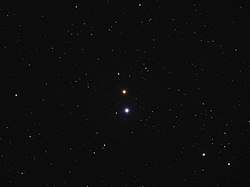12 Camelopardalis
 12 Camelopardalis in optical light | |
| Observation data Epoch J2000.0 Equinox J2000.0 | |
|---|---|
| Constellation | Camelopardalis |
| Right ascension | 05h 06m 12.2s |
| Declination | +59° 01′ 16″ |
| Apparent magnitude (V) | +6.08 |
| Absolute magnitude (V) | −0.332[1] |
| Distance | 625 ± 110 ly (192 ± 34 pc) |
| Spectral type | K0III |
| Other designations | |
12 Camelopardalis is a spectroscopic binary[2] in the constellation Camelopardalis. It also forms a double star with 11 Camelopardalis, which is only 3 arcminutes away.
12 Camelopardalis is classified as an orange K-type giant with a mean apparent magnitude of +6.08. The binary is an RS Canum Venaticorum type variable star and its brightness varies by 0.14 magnitudes with a period of 82.8 days. The orbital period of the binary is 80.174 days. 12 Camelopardalis is approximately 625 light years from Earth.
X-ray source
BM Cam also emits X-rays and is the designated X-ray source 1H 0501+592.[3] It has been detected by HEAO 1, the Einstein Observatory, and ROSAT.
References
- ↑ Böhm-Vitense, Erika; et al. (December 2000), "Ultraviolet Emission Lines in BA and Non-BA Giants", The Astrophysical Journal, 545 (2): 992–999, Bibcode:2000ApJ...545..992B, doi:10.1086/317850.
- ↑ Pourbaix D; Tokovinin AA; Batten AH; Fekel FC; Hartkopf WI; Levato H; et al. (Sep 2004). "SB9: The ninth cataloque of spectroscopic binary orbits". Astron Astrophys. 424 (2): 727–732. arXiv:astro-ph/0406573. Bibcode:2004A&A...424..727P. doi:10.1051/0004-6361:20041213.
- ↑ Wood KS; Meekins JF; Yentis DJ; Smathers HW; McNutt DP; Bleach RD (Dec 1984). "The HEAO A-1 X-ray source catalog". Astrophys. J. Suppl. Ser. 56 (12): 507–649. Bibcode:1984ApJS...56..507W. doi:10.1086/190992.
This article is issued from
Wikipedia.
The text is licensed under Creative Commons - Attribution - Sharealike.
Additional terms may apply for the media files.